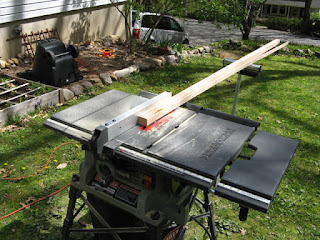We had a glorious day today and I spent it working in my yard, working on my yard. Yes, I pulled my power tools into my yard and commenced ripping and cutting the lumber for the upper spar, also known as a yard. I found another nice piece of Douglas Fir at Home Depot, this time with no knots to speak of. It’s actually an end cut, but the tree must have been fairly large diameter because the curvature of the rings is pretty flat.
If done properly, this 2 x 8 x 10’ board will yield all the cuts I need for a 12’ yard, since I’ve already resigned myself to the fact that scarf joints are inevitable.
(By the way, my wife is the greatest for giving me a table saw as a gift a couple of years ago.)
My first cut was right up the middle.
The next cut is the width of the yard’s diameter. Incidentally, I am omitting any specific dimensions--especially the precise smaller measurements--to safeguard the designer’s proprietary information. If I do mention a measurement like 16 feet, you can rest assured that’s not the actual design specification.
The next cut is also the width of the yard, with only a sliver of fall off as a remainder. These rings have more curvature, so I will minimize the amount of this stock that’s used.
Another center cut. Notice how flat the grain is. It’s not the tightest grain, but I’ve been able to approximate “quarter sawn” gain orientation, which is the most desirable.
There’s JUST barely enough lumber to yield four cuts the with of the yard. Each one of those will then be turned on edge and get ripped down to half the yard’s diameter.
This is the result I’m going for. I’m feeling good. The sun is shining, birds are singing, everything is humming along. And then...
I screwed up. Somehow, I put the wrong end up on this piece. The I cut right through “width” side. Not only is the grain in the wrong orientation, but the resulting width dimension is a couple of millimeters less than what I was going for. Believe me, these plans are spec’d to a tenth of a millimeter, so doing this was WAY off. Well, maybe that’s blowing out of proportion, but at the time it seemed so disastrous that I made my next mistake...
The two “center cuts” were meant to form the majority of the length of the yard. The two “end cuts” would BOTH be used to extend the length through a scarf joint. I needed all four to get to the length of the yard. After making the bad cut, took the remaining “end cut” and chopped it in half thinking it would provide for both extensions.
Except it’s not long enough to do that. There’s only enough length to make 3:1 scarf joints, which is nowhere near enough scarf.
So I ended up using the “bad” cuts after all. They will form stubby extensions at the ends of the yard. I’ve marked the angles for the scarf joints, which will be 10:1, and the picture above shows how the collection of joints will be offset over the length of the yard.
I didn’t cut the angles for the scarf joints yet, just in case I read on the Storer Forum that I should just reduce the length of the yard by 6”. I doubt that’s going be the recommendation though. The stubby ends are also slightly narrower than the other pieces. This is ok (which I should have realized when I discovered the mistake) because the yard gets tapered at both ends, far more than the few millimeters difference in the cuts.
The moral of the story is: don’t get distracted by blue sky and sunshine when operating power tools. Bluebirds aren’t gonna sail your boat for you, so tell them to take a hike and then focus on the lumber!




















